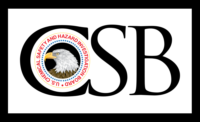The U.S. Chemical Safety Board (CSB) will get an update on the investigation into last year’s blast at the ExxonMobile Refinery in Torrance, California at its upcoming meeting.
Two workers were injured when an explosion occurred in the refinery’s electrostatic precipitator, or ESP, a piece of equipment used at the refinery to control air pollution. A series of events led to the presence of hydrocarbons inside the ESP, where they were never expected, resulting in the explosion. Since the February accident, there have been several other incidents at the refinery, about which CSB investigators have collected data to assist their investigation.
At the public meeting on January 13, 2016, the Board will hear a presentation from the investigative staff on their preliminary findings, areas of future investigation, and the scope of the final report into the accident. The board will also hear comments from the community.
Multiple PSM deficiencies
Chairperson Vanessa Allen Sutherland said, “The CSB is troubled by the February explosion, as well as subsequent incidents that have taken place at the ExxonMobil refinery since February 2015. We look forward to learning and hearing more from the public about those concerns.”
Although the investigation into the explosion at ExxonMobil is ongoing, investigators have already identified multiple process safety management, or PSM, deficiencies that helped contribute to the accident. Many of those failures are similar to findings detailed in the CSB’s investigation and reports on the August 6, 2012, fire at the Chevron refinery in Richmond, California, which endangered 19 workers and sent more than 15,000 residents to the hospital for medical attention. In its final regulatory report into that accident the CSB proposed recommendations for substantial changes to the way refineries are regulated in California.
Regulatory response
The state of California has since worked to revise and strengthen its PSM requirements for refineries and has published a proposed rule. As currently written, the draft PSM regulations address numerous issues raised in the CSB’s Chevron report, such as a risk-reduction goal of “the greatest extent feasible” for process hazard analyses and requirements for performing damage mechanism reviews and hierarchy of controls analysis.
Following the staff presentation at the public meeting in Torrance, the Board will hear an update on the new process safety management reforms in California from a panel of experts. Chairperson Sutherland said, “We are continuing to monitor developments in California and look forward to a lively discussion on PSM reform. I believe the actions being taken in the state are some of the most substantial positive safety changes happening right now. Board Member Engler and I are championing these very important efforts, which are on the agency's Most Wanted List.”
You can attend virtually
The meeting will be webcast live and without charge at the following address: http://LiveStream.com/CitiCABLE
The CSB is an independent federal agency charged with investigating serious chemical accidents. The agency's board members are appointed by the President and confirmed by the Senate. CSB investigations look into all aspects of chemical accidents, including physical causes such as equipment failure as well as inadequacies in regulations, industry standards, and safety management systems.






